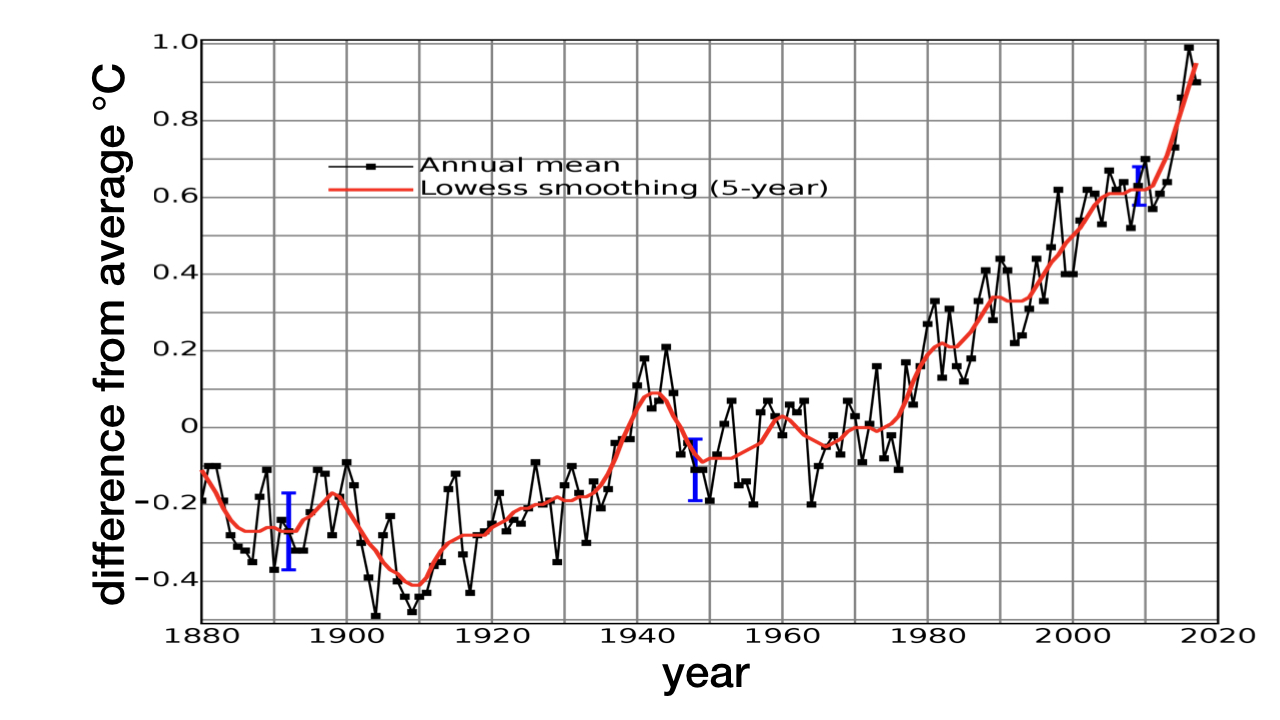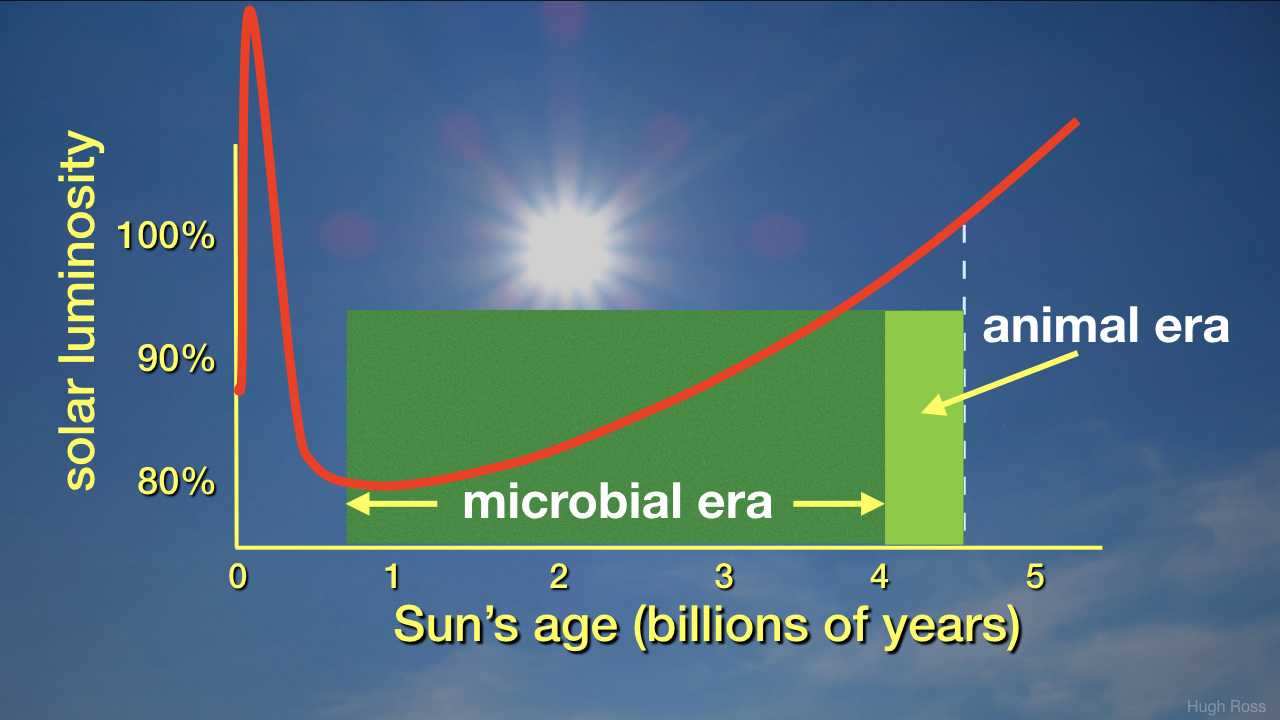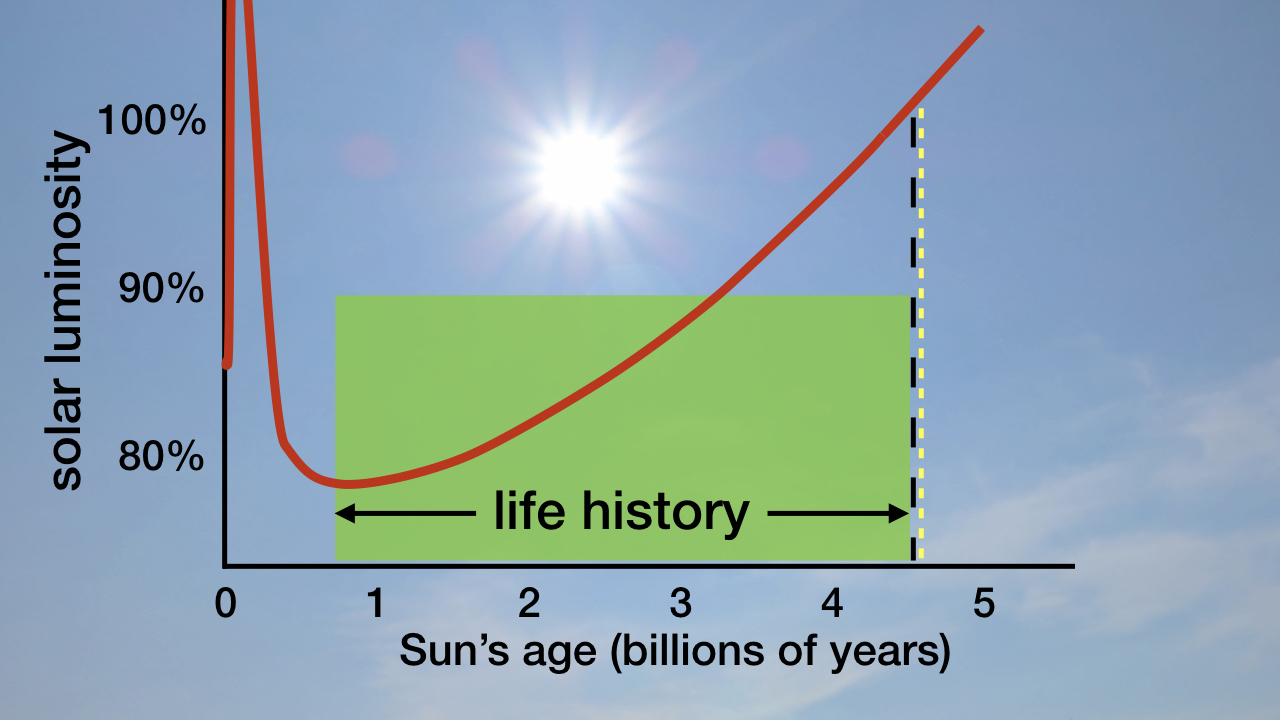Moist Greenhouse Threshold Doomsday
Considerable political and scientific discussion today concerns the possible effects of global warming. Not much attention, however, has been given to potential future water loss—in other words, death by drying out. A major reason why Earth’s water loss has not been publicized is due to large uncertainties in water loss models. A recent paper in the Astrophysical Journal has now brought a measure of certainty to Earth’s inevitable future water loss.1 Is there reason to worry?
Rising Carbon Dioxide Levels
During the past 70 years the global mean temperature has risen by 1°C (see figure 1). There are several causes for this rise, but atmospheric carbon dioxide ranks as the most significant. Carbon dioxide is a greenhouse gas and the more there is of it in the atmosphere, the more the atmosphere traps heat from the Sun.
Before the advent of the industrial and scientific revolutions in 1750, the abundance of carbon dioxide in the atmosphere was 277 parts per million. In 1950, it stood at 312 parts per million. In 1980, it measured 339 parts per million. In 2013, the level surpassed 400 parts per million for the first time in the past million years.2 In 2018, the level broke above 410 parts per million.3

Figure 1: Annual Mean Global Temperatures Relative to Twentieth-Century Average
From 1950 to present, the mean temperature has risen 1°C. Data taken from NOAA National Centers for Environmental Information, Climate at a Glance: Global Time Series (September 2018), https://www.ncdc.noaa.gov/cag/global/time-series.
One way to reverse the present global warming trend would be to reduce the quantity of carbon dioxide in the atmosphere. However, there is a limit to how much carbon dioxide can be removed from the atmosphere without catastrophic consequences for life.
Photosynthesis, the base of the food chain, operates by drawing carbon dioxide from the atmosphere and combining it with water to make sugars, starches, and fats. At 180 parts per million of carbon dioxide in the atmosphere, photosynthesis is seriously degraded. At that level, food crop yields plummet. Food production sufficient to sustain humans and their domesticated animals requires a minimum carbon dioxide level of 200 parts per million. At that level, food crop growth would be limited to elevations near sea level.
Cornell University astronomer Illeana Gómez-Leal and her colleagues examined the consequences of atmospheric carbon dioxide levels at and above 200 parts per million in the context of the ever-brightening Sun. Ever since it ignited hydrogen fusion in its nuclear furnace, the Sun has been getting progressively brighter (see figure 2).

Figure 2: Sun’s Luminosity History
During its formation, the Sun quickly accumulates mass and brightens dramatically. It then loses mass and dims prior to 1 billion years in age. When hydrogen fusion burning begins in the Sun’s core, the Sun’s rate of mass loss drops to a minuscule level. The ignition of hydrogen fusion into helium causes the Sun’s core density to gradually rise. This increasing core density causes the Sun’s nuclear furnace to burn more efficiently, which results in the Sun gradually brightening. Diagram credit: Hugh Ross
Since the origin of life on Earth 3.8 billion years ago, the Sun’s luminosity has increased by about 20 percent. We are now in an epoch where the increase in the Sun’s luminosity is accelerating. Four billion years from now the Sun will be so large and so bright that it will incinerate and vaporize Earth. However, long before the Sun brightens sufficiently to vaporize Earth, the moist greenhouse threshold will be reached.
The Coming Moist Greenhouse Threshold
Carbon dioxide levels above 200 parts per million at the Sun’s current and future brightness levels keep Earth’s troposphere (lower atmospheric layer) humid. With a humid troposphere, the Sun’s ongoing brightening eventually makes water abundant in Earth’s stratosphere (upper atmospheric layer). When that occurs, solar radiation dissociates (splits into hydrogen and oxygen) the water molecules in the stratosphere.
The resultant hydrogen escapes to interplanetary space. (Earth’s gravity is not strong enough to retain free hydrogen.) This hydrogen escape gradually dehydrates Earth. With the loss of Earth’s surface water, all life on Earth dies. The ignition of significant hydrogen escape to interplanetary space is called the moist greenhouse threshold (MGT).
Gómez-Leal’s team determined when, in the context of the ongoing brightening of the Sun, the MGT will occur. They calculated that for atmospheric carbon dioxide levels above 200 parts per million, the MGT will be reached when Earth’s average surface temperature rises to 47°C (117°F). That temperature is just 30°C (54°F) warmer than Earth’s present temperature of 17°C (63°F).
Earth’s average surface temperature for atmospheric carbon dioxide levels above 200 parts per million will reach 47°C when the Sun’s total irradiance (energy) increases by 1.5 percent.4The 1.5 percent figure assumes Earth retains its present covering of ice and snow. But all of Earth’s surface ice and snow will melt when Earth’s global mean surface temperature reaches 21°C (70°F); 4°C (7°F ) warmer than now. The disappearance of Earth’s ice and snow will dramatically lower Earth’s albedo (reflectivity) and immediately raise Earth’s surface temperature by 13°C (23°F).5 Consequently, a solar irradiance increase of just 1.1 percent is enough to bring on the MGT.
Figure 3 shows that the MGT will occur just a few tens of millions of years from now—even faster at higher atmospheric carbon dioxide levels. However, the MGT marks only the beginning of Earth’s desiccation. Earth will not become “bone dry” for another 2.8 billion years.6 Nevertheless, it takes only a slight loss of surface water for advanced life on Earth to be driven to extinction. Human civilization will be the first to go.

Figure 3: Timing of the Moist Greenhouse Threshold
The vertical black dotted line indicates where we are right now relative to the Sun’s luminosity history. The vertical yellow dotted line indicates when the moist greenhouse threshold will be reached. Diagram credit: Hugh Ross
Philosophical Implications of the MGT
Gómez-Leal and her team offer no comment on the philosophical implications of their research. However, at least three jump out. One implication concerns the timing of humanity’s entry on the terrestrial scene. If the origin of humanity had occurred any earlier, humans would have lacked adequate biodeposit resources from previously existing life on Earth to launch and sustain global high-technology civilization. If the origin of humanity had occurred any later, food crop productivity would have been insufficient to sustain billions of humans and their domesticated animals. The timing of our origin, therefore, seems more purposeful than accidental.
A second implication points to the fine-tuning design for human existence and global human civilization. Evidently, we live on a planet with a just-right atmosphere at a just-right distance from a just-right star at a just-right time in the history of that star.
Third, it appears that the intended purpose for the creation of human beings will be fulfilled, at least on an astronomical time scale, within a relatively brief epoch. The Cornell researchersdemonstrate that the time window for global human civilization likely is briefer than 10 million years. Given this interval, the Bible reveals that the Creator intends for humanity to fulfill its destiny within this creation and, for whoever so desires, to enter into the new creation soon.7
Check out more from Reasons to Believe @Reasons.org
Endnotes
- Illeana Gómez-Leal et al., “Climate Sensitivity to Carbon Dioxide and the Moist Greenhouse Threshold of Earth-Like Planets under an Increasing Solar Forcing,” Astrophysical Journal 869, no. 2 (December 20, 2018): id. 129, doi:10.3847/1538-4357/aaea5f.
- Randy Showstack, “Carbon Dioxide Tops 400 ppm at Mauna Loa, Hawaii,” Eos, Transactions, American Geophysical Union 94, no. 21 (May 21, 2013): 192–93, doi:10.1002/2013EO210004.
- Rob Monroe, “Carbon Dioxide in the Atmosphere Hits Record High Monthly Average,” Scripps Institution of Oceanography (May 2, 2018), https://scripps.ucsd.edu/programs/keelingcurve/2018/05/02/carbon-dioxide-in-the-atmosphere-hits-record-high-monthly-average/.
- Gómez-Leal et al., “Climate Sensitivity,” p. 1.
- Gómez-Leal et al., “Climate Sensitivity,” pp. 6–7.
- Gómez-Leal et al., “Climate Sensitivity,” p. 12.
- Hugh Ross, Why the Universe Is the Way It Is (Grand Rapids, MI: Baker, 2008).





